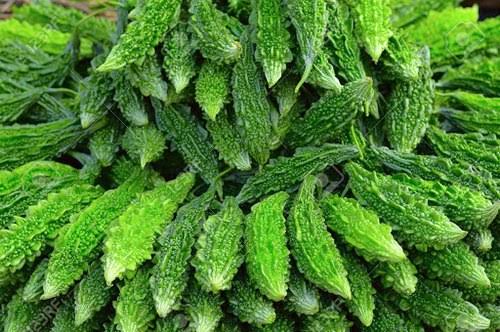Bitter gourd (Momordica charantia) is an important vegetable and is grown for its immature tubers, which have a unique bitter taste. Fruits are considered rich in vitamins and minerals as well as 88 mg of vitamin C per 100 g. The fruit is used after cooking, and a delicious preparation is made after it is stuffed and fried. When the market is too saturated, the fruit is cut into pieces, partially boiled with salt and dried in direct sunlight and stored for months. It is used after frying. Pare has medicinal value and is used to treat diabetes, asthma, blood disorders, and rheumatism. Drinking fresh bitter gourd juice is recommended by naturopaths. Bitter gourd roots and stems are used in many Ayurvedic remedies.
Nutrition :
One Fresh Bitter Gourd Provide :
- Calories : 21
- Protein : 1gm
- Carbs : 5gm
- Fiber : 3gm
- Sodium : 6mg
Vitamin & Minerals :
- Vitamin A
- Vitamin C
- Vitamin B1
- Vitamin B2
- Vitamin B3
- Folic Acid
- Calcium
- Iron
- Potassium
- Zinc
- Phosphorus
- Magnesium
Benefits :
Good For Diabetics :
Bitter gourd has compounds that work like insulin. In fact, "Karela and Diabetes" are often found together! It lowers blood sugar levels in type I and type II diabetes. Consuming a glass of Karela juice is so effective that diabetic patients should reduce the dosage of the medicine.
Good For Skin & Hair :
Karela is rich in antioxidants and vitamins A and C, which are good for the skin. Reduces aging and fights acne and blemishes. It is useful in treating various skin infections such as ringworm, psoriasis, and itching. Karela juice adds shine to hair and fights dandruff, hair loss and split ends
Liver Cleanser :
Bitter gourd is good for the liver and detoxification. It increases liver enzymes and is a good hangover remedy as it reduces the buildup of alcohol in the liver. The bladder and intestines also benefit from eating Karela.
Good For Digestion :
Karela is rich in fiber and helps in smooth bowel movements. It relieves constipation and soothes the stomach.
Improves Heart Health :
Bitter gourd reduces LDL (bad cholesterol) and reduces the risk of heart attack. Fiber also helps clean the arteries.
Fight Cancer :
Karela strengthens immunity and prevents allergies and infections. However, its greatest benefit is fighting cancer. It works against the multiplication of cancer cells and stops the formation of tumors. The risk of breast, colon and prostate cancer is significantly reduced after regular consumption of bitter gourd.
Weight Management :
Karela helps you lose weight because it is low in calories and high in fiber. It stops the formation and growth of fat cells that store fat in the body. It boosts metabolism and antioxidants help detoxify the body, which leads to fat reduction.
Heal Wounds :
Karela has great healing properties. It controls blood flow and clotting, which helps wounds heal faster and reduces infection.
Blood Purifier :
Karela is rich in antioxidants and this helps it treat many problems related to damaged blood. Regular consumption of bitter gourd improves skin, hair and cancer problems. It also helps improve blood circulation.
Energizes Body :
Endurance and energy levels of the body show a remarkable increase after consuming Karela regularly. It even helps improve sleep quality and reduces sleep problems such as insomnia.
Ways To Consume Bitter Gourd :
- You can make a delicious Karela sabzi and enjoy for lunch/dinner.
- Squeeze the karela raw and consume it for its amazing health benefits.
- With the help of Karela, make a delicious spicy filling and enjoy the stuffed prawns.
- Fry thin slices of Karelia and your healthy Karelia chips are ready to eat.






Comments